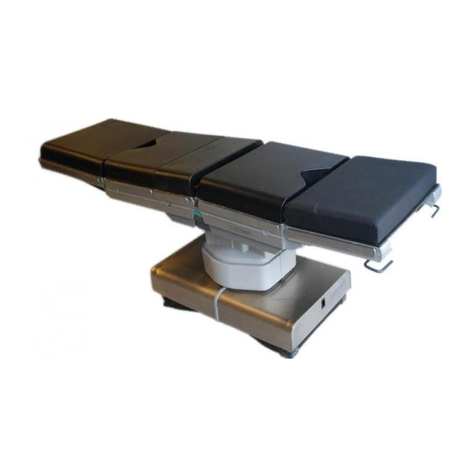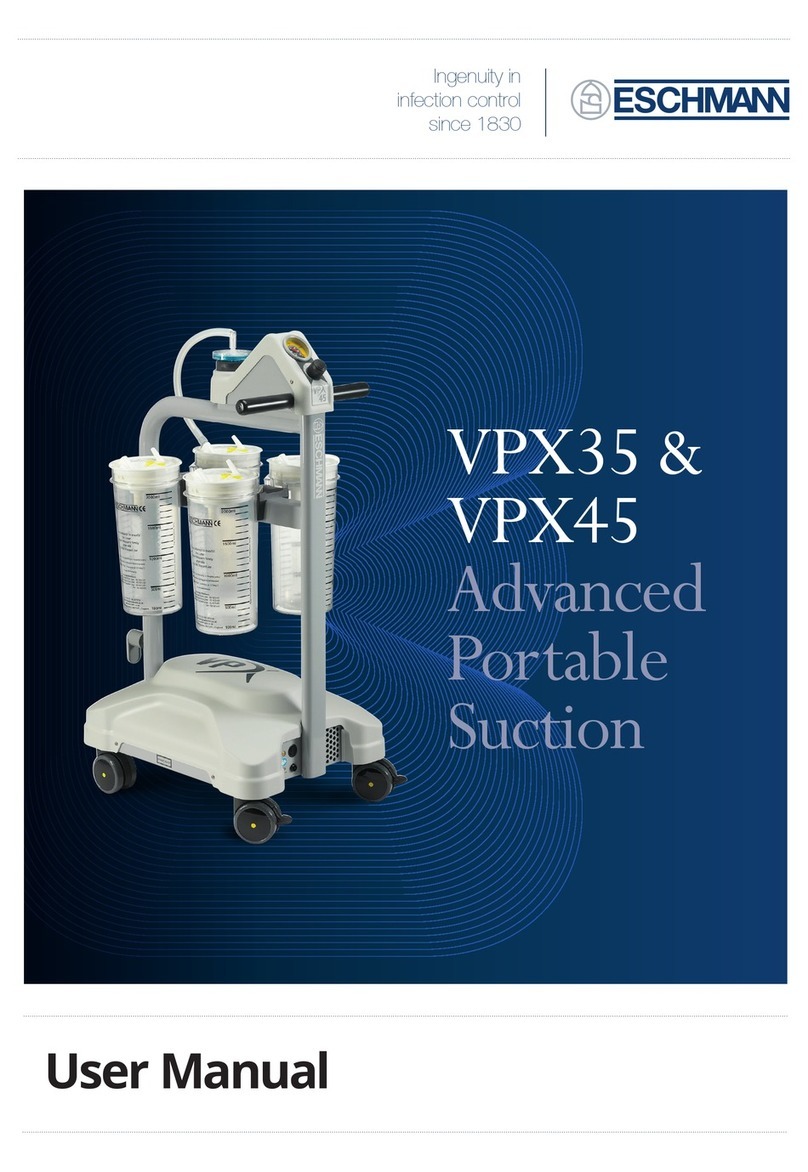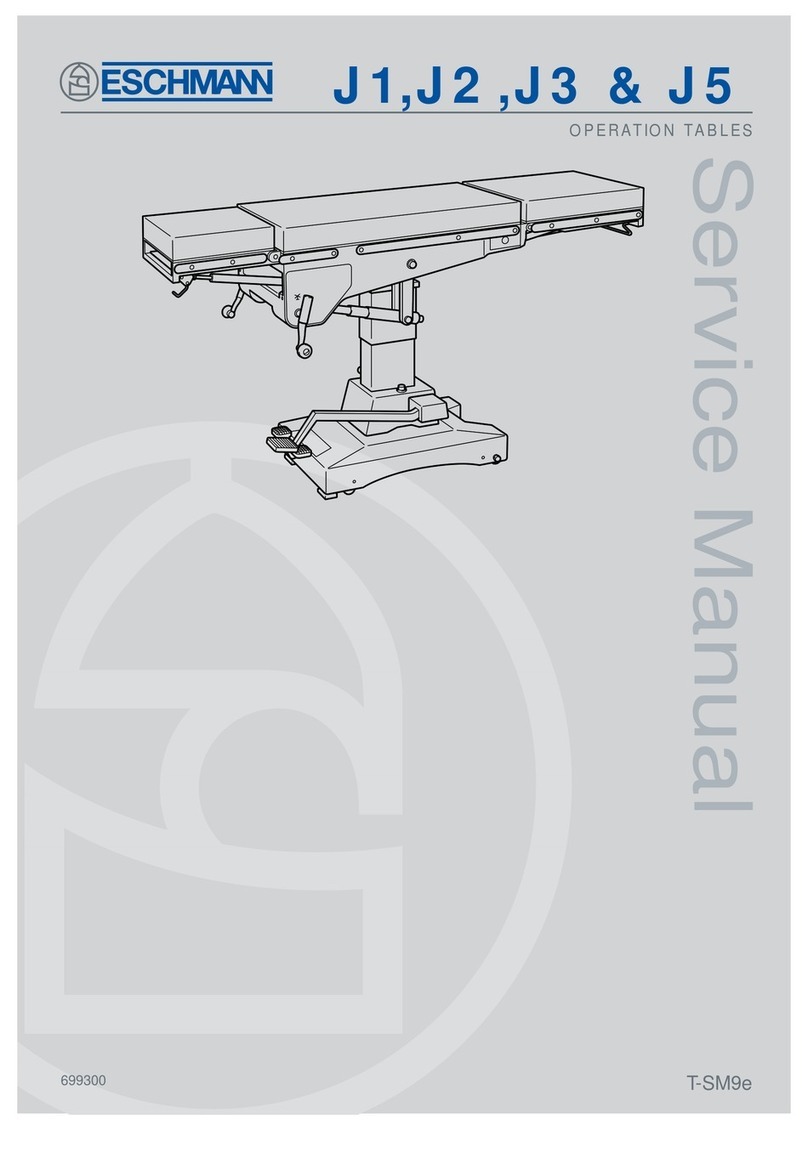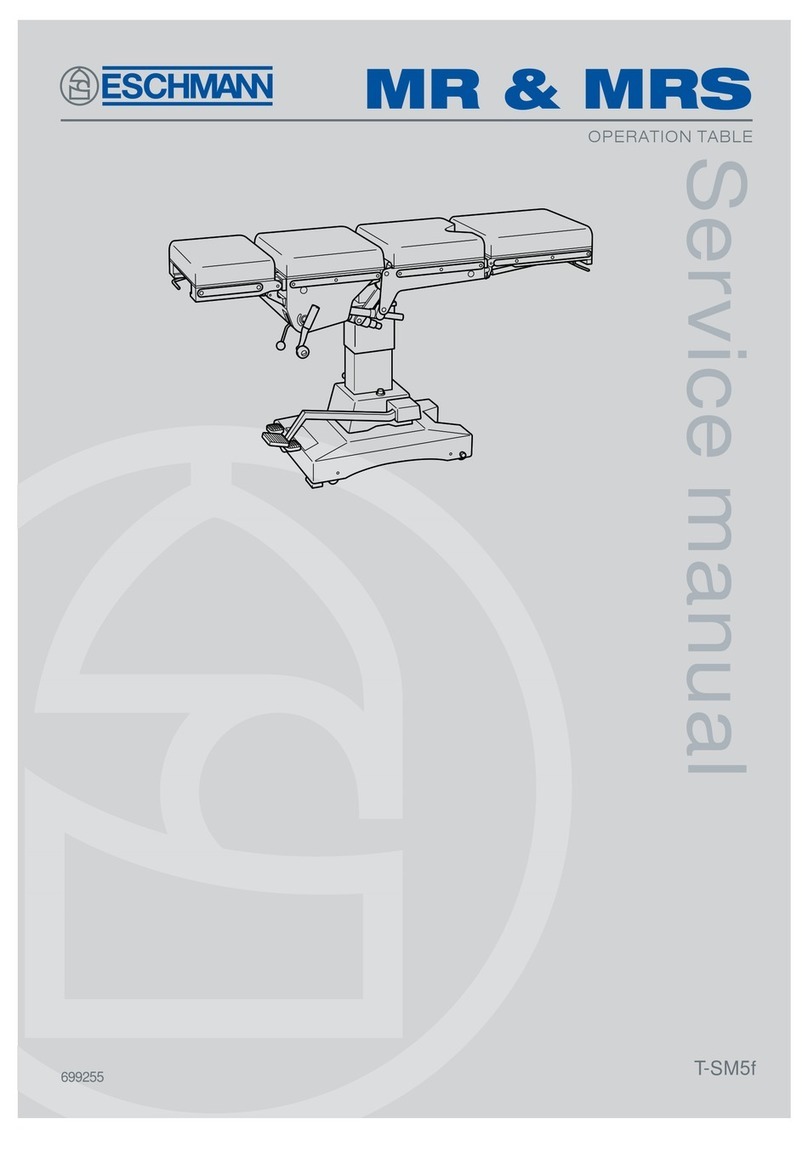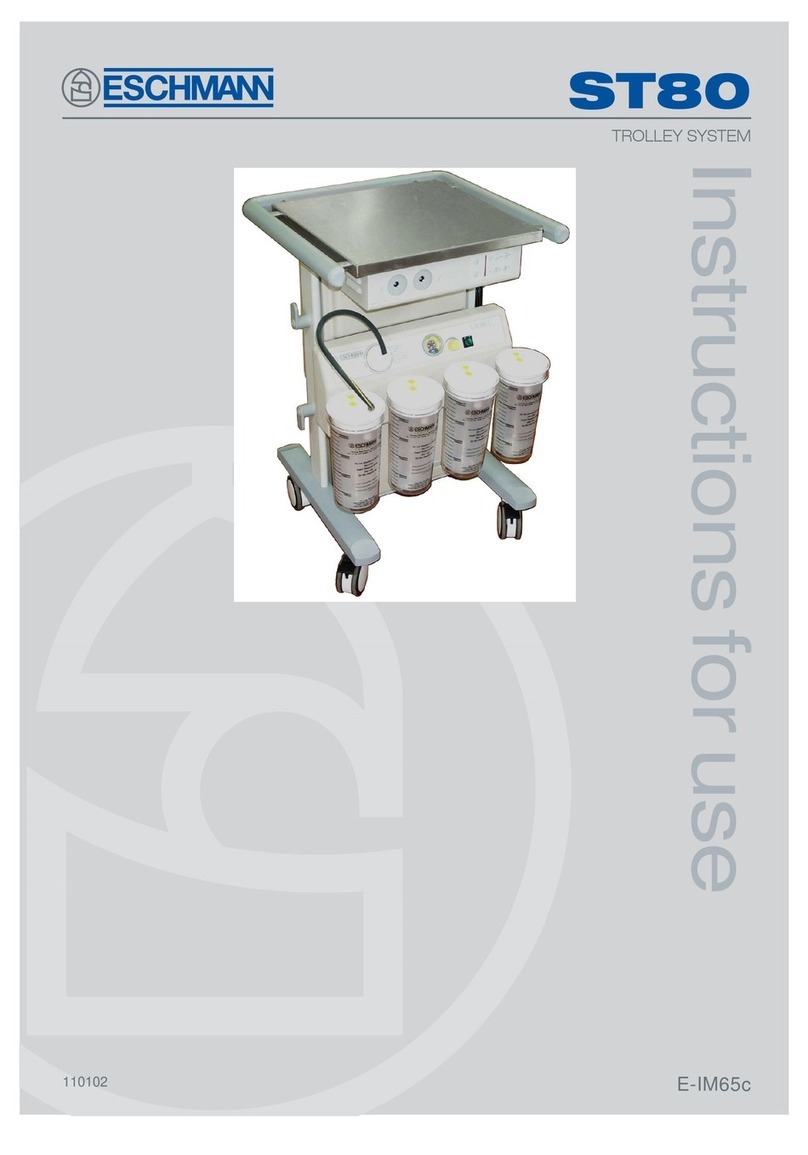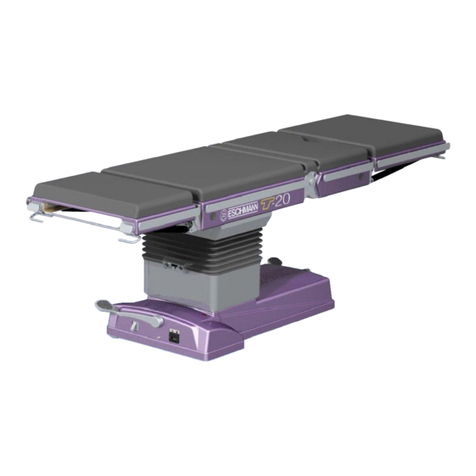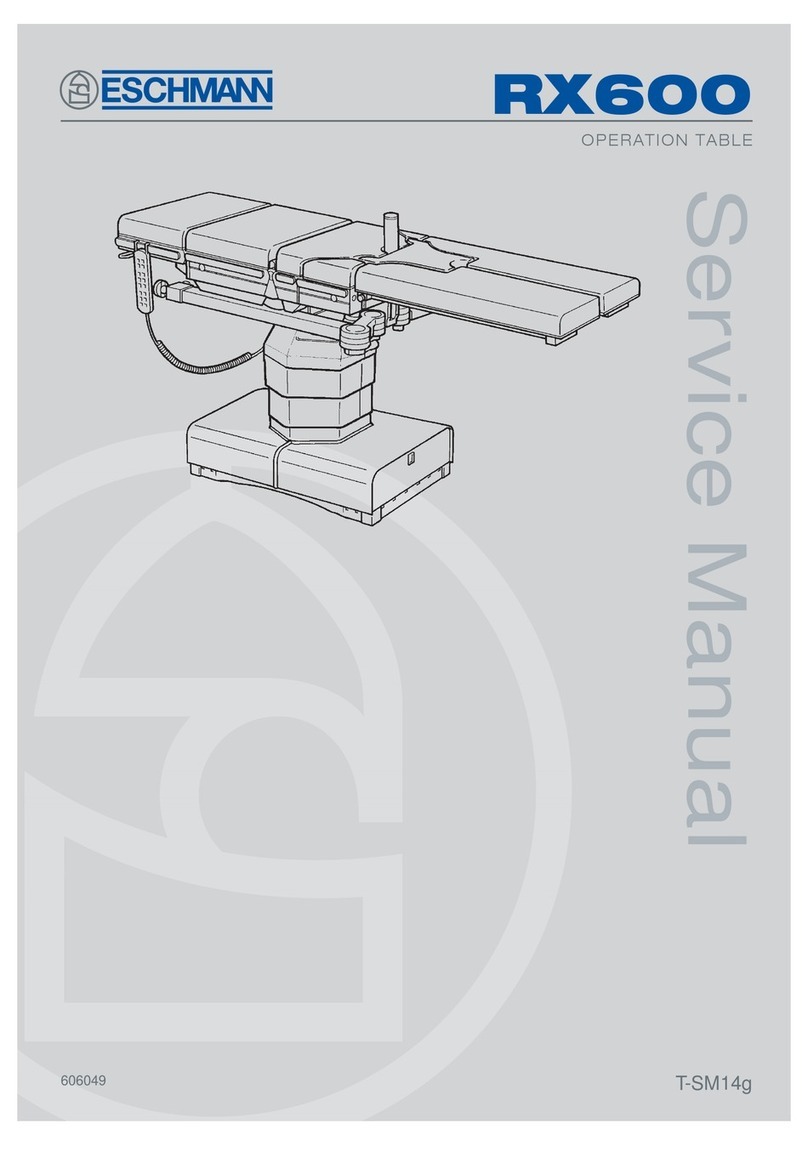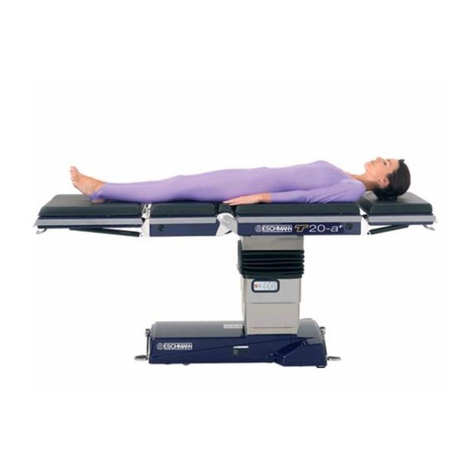eschmann TD830 User manual

TD830
E LECT RO SURGICAL UNIT
Instructions for use
E-IM54f
698257

Instructions for use
Preliminary
Information
Technical data
Safety notes
and alarms
Operation
Cleaning, disinfection
and care
Accessories
Read these Instructions before use
Keep these ‘Instructions for use’ in a safe convenient place for future reference. Read in
conjunction with the relevant Publications detailed in the preliminary information section.
Eschmann After Sales Service Department
The Eschmann After Sales Service Department is staffed and equipped to provide advice and
assistance during normal office hours. To avoid delays when making enquiries, please quote the
Model and Serial Number of your Electrosurgical Unit which is shown on the Serial Number plate,
the location of which is shown below. Please ensure you include all alpha and numeric digits of
the Serial Number.
For further information visit www.eschmann.co.uk
All correspondence relating to the after sales service of Eschmann Equipment to be addressed to :
UK Customers
Eschmann Equipment, Peter Road, Lancing, West Sussex BN15 8TJ, England.
Tel: +44 (0) 1903 765040. Fax: +44 (0) 1903 875711.
Overseas Customers
Contact your local distributor. In case of doubt contact Eschmann Equipment.
Patents and Trade marks
The ESCHMANN name and logo are registered trade marks of Eschmann Holdings Limited.
“Eschmann Equipment” is a trading name of Eschmann Holdings Limited.
“TD830” is a trade mark of Eschmann Holdings Limited.
Patents : GB2276551, GB2146534,AU673883, ZA94/2173, US5480399,
EP617925, IEE69100 and other Patents Pending.
Copyright © 2006 Eschmann Holdings Limited
All rights reserved. This booklet is protected by copyright. No part of it may be reproduced, stored in a
retrieval system or transmitted in any form or by any means, electronic, mechanical, photocopying,
recording or otherwise without written permission from Eschmann Holdings Limited.
The information in this publication was correct at the time of going to print. The Company, however,
reserves the right to modify or improve the equipment referred to.
The CE marking affixed to the product certifies that it complies with the
European Medical Devices Directive 93/42/EEC and related legislation.
E-IM54f July 2006
The Serial Number plate
is located here, (view
from rear of unit).

E-IM54f P3/37
TD830
ELECTROSURGICAL UNIT
CONTENTS
1. PRELIMINARY INFORMATION
Preliminary information . . . . . . . . . . . . . . . . . . . . . . . . 4
2. TECHNICAL DATA
General . . . . . . . . . . . . . . . . . . . . . . . . . . . . . . . . . . . 5
Dimensions . . . . . . . . . . . . . . . . . . . . . . . . . . . . . . . . . 5
Electrical data . . . . . . . . . . . . . . . . . . . . . . . . . . . . . . . 5
Audible indicators . . . . . . . . . . . . . . . . . . . . . . . . . . . . 6
Visual indicators . . . . . . . . . . . . . . . . . . . . . . . . . . . . . 6
Safety.. .. . . . . . . . . . . . . . . . . . . . . . . . . . . . . . . . . . . 6
Duty cycle . . . . . . . . . . . . . . . . . . . . . . . . . . . . . . . . . . 7
Other symbols . . . . . . . . . . . . . . . . . . . . . . . . . . . . . . . 7
Button symbols . . . . . . . . . . . . . . . . . . . . . . . . . . . . . . 7
Alarm symbols . . . . . . . . . . . . . . . . . . . . . . . . . . . . . . . 8
Environmental conditions for transport and storage . . . 8
3. SAFETY NOTES & ALARMS
Do’s and Don’ts . . . . . . . . . . . . . . . . . . . . . . . . . . . . . . 9
Alarm circuits . . . . . . . . . . . . . . . . . . . . . . . . . . . . . . . 10
4. INTRODUCTION
General .. . . . . . . . . . . . . . . . . . . . . . . . . . . . . . . . . . 11
Operating modes / display option.. . . . . . . . . . . . . . . 11
Accessories . . . . . . . . . . . . . . . . . . . . . . . . . . . . . . . . 11
Associated Publications . . . . . . . . . . . . . . . . . . . . . . . 11
Equipment certification . . . . . . . . . . . . . . . . . . . . . . . 11
Electrosurgical techniques . . . . . . . . . . . . . . . . . . . . . 12
General . . . . . . . . . . . . . . . . . . . . . . . . . . . . . . . . 12
Monopolar electrosurgery . . . . . . . . . . . . . . . . . . . 12
Plate electrode . . . . . . . . . . . . . . . . . . . . . . . . 12
Footswitches . . . . . . . . . . . . . . . . . . . . . . . . . . 12
Active electrode handles . . . . . . . . . . . . . . . . . 12
Active cables . . . . . . . . . . . . . . . . . . . . . . . . . . 13
Active electrodes . . . . . . . . . . . . . . . . . . . . . . . 13
Fingerswitches . . . . . . . . . . . . . . . . . . . . . . . . 13
Power control . . . . . . . . . . . . . . . . . . . . . . . . . 13
Current paths . . . . . . . . . . . . . . . . . . . . . . . . . . 13
Accidental contact . . . . . . . . . . . . . . . . . . . . . . 13
Bipolar electrosurgery . . . . . . . . . . . . . . . . . . . . . . 13
General . . . . . . . . . . . . . . . . . . . . . . . . . . . . . .13
Flammable anaesthetics and spirits . . . . . . . . . . . 14
Implanted cardiac pacemakers . . . . . . . . . . . . . . . 14
General . . . . . . . . . . . . . . . . . . . . . . . . . . . . . . 14
Risks . . . . . . . . . . . . . . . . . . . . . . . . . . . . . . . . 14
Precautions . . . . . . . . . . . . . . . . . . . . . . . . . . . 14
Electrosurgical interference . . . . . . . . . . . . . . . . . 14
Using two electrosurgical units . . . . . . . . . . . . . . . 15
Using a flexible endoscope . . . . . . . . . . . . . . . . . . 15
Servicing . . . . . . . . . . . . . . . . . . . . . . . . . . . . . . . . . . 15
References . . . . . . . . . . . . . . . . . . . . . . . . . . . . . . . . 15
5. OPERATION
Routine check . . . . . . . . . . . . . . . . . . . . . . . . . . . . . . 16
Connection of accessories . . . . . . . . . . . . . . . . . . . . 16
Monopolar . . . . . . . . . . . . . . . . . . . . . . . . . . . . . . 16
Bipolar . . . . . . . . . . . . . . . . . . . . . . . . . . . . . . . . . 17
System check . . . . . . . . . . . . . . . . . . . . . . . . . . . . . . 17
Operating instructions . . . . . . . . . . . . . . . . . . . . . . . . 18
Monopolar standby mode . . . . . . . . . . . . . . . . . . . 18
Monopolar mode . . . . . . . . . . . . . . . . . . . . . . . . . . 18
USER 1 and/or USER 2 selection . . . . . . . . . . 18
Plate electrode . . . . . . . . . . . . . . . . . . . . . . . . 19
Fingerswitch/active electrode handle . . . . . . . . 19
Footswitches . . . . . . . . . . . . . . . . . . . . . . . . . . 19
Monopolar outputs . . . . . . . . . . . . . . . . . . . . . . 20
Power output . . . . . . . . . . . . . . . . . . . . . . . . . . 20
Bipolar Mode . . . . . . . . . . . . . . . . . . . . . . . . . . . . 21
Selecting bipolar forceps . . . . . . . . . . . . . . . . . 21
Connecting forceps . . . . . . . . . . . . . . . . . . . . . 21
Changing forceps . . . . . . . . . . . . . . . . . . . . . . 21
Footswitches . . . . . . . . . . . . . . . . . . . . . . . . . . 21
Power output . . . . . . . . . . . . . . . . . . . . . . . . . . 21
After use . . . . . . . . . . . . . . . . . . . . . . . . . . . . . . . . 21
Disconnecting accessories . . . . . . . . . . . . . . . . . . 21
Power output selection guide . . . . . . . . . . . . . . . . 21
Alarms . . . . . . . . . . . . . . . . . . . . . . . . . . . . . . . . . . 22
Alarm conditions . . . . . . . . . . . . . . . . . . . . . . . . . . 22
Alarm identifications and remedies . . . . . . . . . . . . 22
TABLE 1 - Power output selection guide . . . . . . . . . . 24
Output diagrams . . . . . . . . . . . . . . . . . . . . . . . . . . . . 25
6. CLEANING, DISINFECTION & CARE
Cleaning and disinfection . . . . . . . . . . . . . . . . . . . . . . 32
Cleaning the electrosurgical unit . . . . . . . . . . . . . . 32
Disinfecting the electrosurgical units . . . . . . . . . . . 32
Electrosurgical accessories . . . . . . . . . . . . . . . . . 32
Care . . . . . . . . . . . . . . . . . . . . . . . . . . . . . . . . . . 32
Service . . . . . . . . . . . . . . . . . . . . . . . . . . . . . . . . . 32
Additional information . . . . . . . . . . . . . . . . . . . . . . 32
Maintenance procedures . . . . . . . . . . . . . . . . . . . 32
Accessories . . . . . . . . . . . . . . . . . . . . . . . . . . . . . . . . 32
7. ACCESSORIES
Accessory list . . . . . . . . . . . . . . . . . . . . . . . . . . . . 33
ILLUSTRATIONS
1 - 5 . . . . . . . . . . . . . . . . . . . . . . . . . . . . . . . . . 34
6 - 8 . . . . . . . . . . . . . . . . . . . . . . . . . . . . . . . . . 35
9 - 10 . . . . . . . . . . . . . . . . . . . . . . . . . . . . . . . . 36
12 . . . . . . . . . . . . . . . . . . . . . . . . . . . . . . . . . . 37

P4/37 E-IM54f
1. PRELIMINARY INFORMATION
1.1 These Instructions for Use should be referred to for
details of the TD830 Electrosurgical Unit, REF 83-256-01,
83-257-02, 83-258-03, 83-259-04, 83-260-05, 83-261-01,
83-262-07, 83-263-08, and 83-264-09 (serial number
A9B0000 or above).
1.2 Within the text of this manual the term ‘coag’ is used
as a common abbreviation of the term ‘coagulation’.
1.3 Carefully remove the TD830 Electrosurgical Unit and
its associated accessories from the packing case(s).
1.4 Place the TD830 Electrosurgical Unit on a stable
convenient working platform, for example on the Eschmann
ST80 mobile trolley, purpose built for carrying
electrosurgical units.
1.5 The TD830 Electrosurgical Unit requires a mains
electrical supply corresponding to the voltage shown on
the electrical rating plate at the rear of the unit. Only use
the mains supply cable supplied. If the plug supplied pre-
fitted is not suitable it should be replaced with a suitable
plug with protective earthing contact.
1.6 If the plug is a fused type, a 10A fuse must be fitted.
CAUTION
It is most important that fuses of the correct
type, size and rating are installed (see Technical
Data).
CAUTION
Read these ‘Instructions for use’ carefully
before using this electrosurgical unit and note
ALL of the warnings, cautions and safety notes
contained within. Keep these ‘Instructions for
use’ close-to-hand at all times for reference.
Please note that Fig. 11 at the end of this manual
opens out so that it can be refered to easily whilst
reading this manual. It is the main figure
identifying the various parts of the TD830
Electosurgical Unit.
1.7 Ensure that the unit ‘mains’ switch (42 of Fig. 11) is
in the ‘O’ position and that the output controls are set to
minimum before connecting to, and switching ‘on’, the
mains supply. Acomplete systems check must be carried
out before using the Electrosurgery Unit (see Sections 5.10
to 5.17).
1.8 Instruction and Service Manuals should be readily
accessible for reference prior to and when operating,
cleaning and servicing the TD830 Electrosurgical Unit. All
manuals are available from Eschmann Equipment, see
inside front cover for address details.
Related Technical Publications
Service Manual for TD830
Publication number E-SM44, Part No. 698260
Eschmann accessory ‘Instructions for use’
Publication number E-IM50, Part No.604802

E-IM54f P5/37
TD830
ELECTROSURGICAL UNIT
2. 0 TECHNICAL DATA
GENERAL
The TD830 Electrosurgical Unit (or Surgical Diathermy
Unit) is classified as ‘HF surgical equipment’ 1
1- ‘HF surgical equipment’ is defined as, “Medical
electrical equipment including its associated accessories
intended for the performance of surgical operations, such as
the ‘cutting’ 2or ‘coagulation’ 3 of biological tissue by means of
high frequency (h.f.) currents”.
2- ‘Cutting’ is defined as, “Resection or dissection of body
tissue caused by the passage of high frequency current of high
current density at the active electrode(s)”.
3- ‘Coagulation’ is defined as, “Sealing of small blood
vessels or of body tissue caused by the passage of high
frequency current at the active electrode(s)”.
Equipment - High power electrosurgical unit with
monopolar and bipolar outputs
Type - Portable
DIMENSIONS
Width . . . . . . . . . . . . . . . . . . . . . . . . . . . . . .39.0 cm
Height . . . . . . . . . . . . . . . . . . . . . . . . . . . . . .19.0 cm
Length . . . . . . . . . . . . . . . . . . . . . . . . . . . . .42.5 cm
Weight . . . . . . . . . . . . . . . . . . . . . . . . . . . . . . .14 kg
ELECTRICAL DATA
(Note: Voltage factory set by transformer tapping, according
to model supplied.)
Power Supply . . . . . . . . . . . . . . . . . 230V a.c., 50-60Hz
or, 240V a.c., 50-60Hz
or, 220V a.c., 50-60Hz
or, 110V a.c., 50-60Hz
Current (max.) . . . . . . . . . 4.4A (230V) or, 4.2A (240V)
or, 4.6A (220V) or, 8.4A (110V)
Fuse rating (240V, 230V, 220V) . . . . . . . . . . . 250V, T5A
Fuse rating (110V) . . . . . . . . . . . . . . . 125V(min.),T10A
Fuse type . . . . . . . . . . . . . . . . . . . . . . . . . . . . . . 20 mm
Bipolar
Carrier frequency - 785kHz nominal, square wave.
Power control - Variable pulse group modu-lation set
by front panel control. Amplitude set by micro/macro range
buttons.
Load resistance for maximum output power
- 100 ohms (non-inductive) for Macro
- 50 ohms (non-inductive) for Micro
Test load - 100 ohms (non-inductive)
Output (bipolar)
Peak
Open
Crest Circuit
Symbol/Function Power factor Voltage
Coagulation
Micro range 17W ±20% Variable 150
Macro range 50W -20% Variable 230
Power and voltage output data diagrams are shown at the
end of section 5.
Monopolar
Carrier frequency - 475kHz nominal, square wave.
Power control - Variable amplitude set by frontpanel
controls. Preset pulse patterns set by mode switches.
Load resistance for maximum output power is 150 ohms
(non-inductive) for cut and pinpoint coag and 200 ohms
(non-inductive) for blend, specialist cut and spray coag.
Test load is 200 ohms (non-inductive) for cut and specialist
cut and 400 ohms (non-inductive) for blend, spray coag
and pinpoint coag.
Output (monopolar)
Output powers are measured to an accuracy of ±20%,
with a maximum power of 400 watts.
Peak
Open
Crest Circuit
Symbol/Function Power factor Voltage
Normal cut 345W(-20%) 1.9 1150
Blend 300W(±20%) 3.0 2200
Specialist cut 345W(-20%) 2.1 1500
Pinpoint coag. 170W(±20%) 5.1 2150
Spray coag. 79W(±20%) 8.7 4000
Power and voltage output data diagrams are shown at the
end of section 5.
+10%
Table of contents
Other eschmann Medical Equipment manuals
Popular Medical Equipment manuals by other brands

Getinge
Getinge Arjohuntleigh Nimbus 3 Professional Instructions for use

Mettler Electronics
Mettler Electronics Sonicator 730 Maintenance manual

Pressalit Care
Pressalit Care R1100 Mounting instruction

Denas MS
Denas MS DENAS-T operating manual

bort medical
bort medical ActiveColor quick guide

AccuVein
AccuVein AV400 user manual
